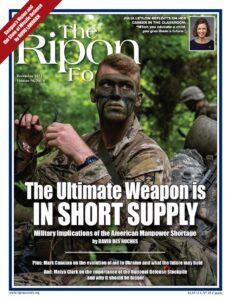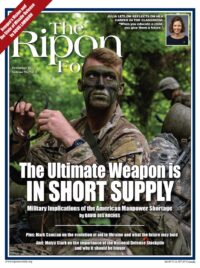 After the worst year for military recruiting since the start of the all-volunteer force in 1973, the latest edition of The Ripon Forum focuses on U.S. military readiness at a time of rising tensions around the globe.
After the worst year for military recruiting since the start of the all-volunteer force in 1973, the latest edition of The Ripon Forum focuses on U.S. military readiness at a time of rising tensions around the globe.
Leading the Forum’s coverage is David Des Roches, an associate professor at the National Defense University and Airborne Ranger in the Army Reserve. In an essay entitled, “The Ultimate Weapon is in Short Supply,” Des Roches lays out six possible reasons for the recruitment crisis, including the fact that “the pool of eligible Americans is shrinking.”
“To serve in the military,” Des Roches writes, “a young American has to be relatively physically fit, not have a history of drug abuse, and not have an emotional or mental health condition. These standards were devised in a different era for a different society. Now, obesity is rampant in America, marijuana (and other drugs) are socially accepted and increasingly legal.”
“Unfortunately, these conditions can be disqualifying for military service; less than one-in-four Americans in the target age group are eligible for service. This is not solely a military problem, but rather a comprehensive whole-of-society failure and no less than a national disgrace.”
The recruitment shortfall is not the only challenge impacting U.S. military readiness. According to Mark F. Cancian of the Center for Strategic and International Studies, our Armed Forces also face the challenge of maintaining an adequate stockpile of weapons at a time when lethal assistance is being sent to Ukraine and making a difference in its war against Russia.
“The United States has sent 8,500 Javelins to Ukraine, about 40 percent of its inventory,” Cancian writes. “Prewar production was 1,000 per year. The Department of Defense is working to expand this, but even at double the prewar production rate, replacing the transferred Javelin inventory would take four years of production. With a two-year lead time, that means a rebuilt inventory in 2028.”
Maiya Clark of the Heritage Foundation writes about another U.S. stockpile that is facing a possible shortage — and that is the National Defense Stockpile of raw materials needed to manufacture critical items ranging from ships and planes to ammunition and body armor.
“Today, the stockpile is but a fraction of its former self,” Clark writes. “Its cache of materials is valued at less than $1 billion. Corrected for inflation, that’s less than 1/40th of its value in 1952. The stockpile is all the more important today because, in many cases, the primary supplier of the raw materials it contains is also America’s chief global competitor: China … This is a massive national security risk.”
Another national security risk is America’s aging nuclear deterrent. According to author, professor, and America Enterprise Institute nonresident fellow John D. Maurer, renewed attention is being paid to America’s arsenal as a result of Vladimir Putin’s dangerous threats to use nuclear weapons in Ukraine and the decision by China to build its own nuclear arsenal equal to America’s in size. Unfortunately, Maurer writes: “While the threats from China and Russia have matured, much of the American nuclear arsenal has aged far beyond its useful lifespan. The U.S. nuclear arsenal is currently supported by last century’s equipment: 40-year-old submarines, 50 year-old missiles, and 70-year-old bombers.”
Nearly 40 years after Ronald Reagan first proposed that the U.S. develop a shield to protect Americans against a nuclear attack, U.S. Rep. Doug Lamborn (CO-5) looks back at Reagan’s proposal and the state of U.S. missile defense. “Today, the missile threat environment is far more complicated and perilous than at any other time in history,” writes Lamborn, who serves as the top Republican on the Armed Services Committee’s Strategic Forces Subcommittee. “China, Russia, North Korea, and potentially Iran are deliberately developing strategies to threaten the U.S. homeland … Despite recognizing these threats and repeatedly proclaiming that the defense of the American homeland is their number one priority, the Biden Administration’s Missile Defense Review puts forth a ‘business as usual’ approach.”
With Republicans set to take control of the House of Representatives, the latest Forum also features a debate over whether America is spending enough on national defense. Roger I. Zakheim of the Reagan Institute argues the GOP should take a page from the Reagan playbook and support a defense budget with at least five percent growth annually, while Robert Weissman of Public Citizen argues that, after failing five straight audits, the Pentagon neither deserves nor needs a funding boost.
In other essays, Bill Woolf of the Space Force Association examines the state of the U.S. Space Force as it marks its third anniversary this month, and former Border Patrol agent Victor M. Manjarrez, Jr., of the Center for Law and Human Behavior at the University of Texas at El Paso, examines the state of security along America’s southern border. And in our latest Ripon Profile, Louisiana Congresswoman Julia Letlow discusses her background in education and reveals which federal agency she would most like to reform.
As always, we hope you enjoy this edition of the Forum, and welcome any comments or questions you may have.
Lou Zickar
Editor of The Ripon Forum
louzickar@clu.ccw.mybluehost.me




